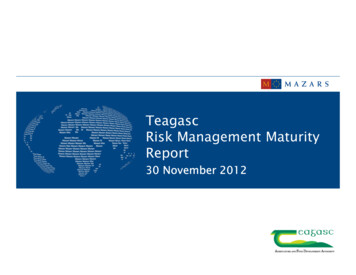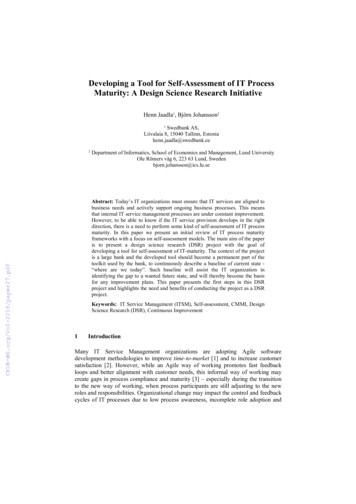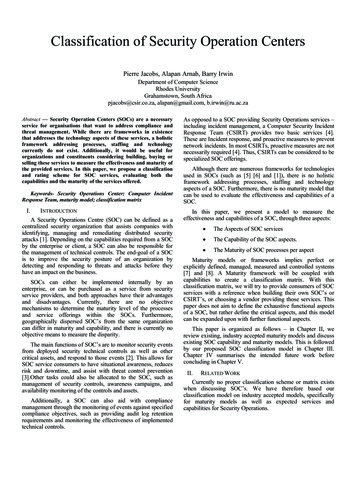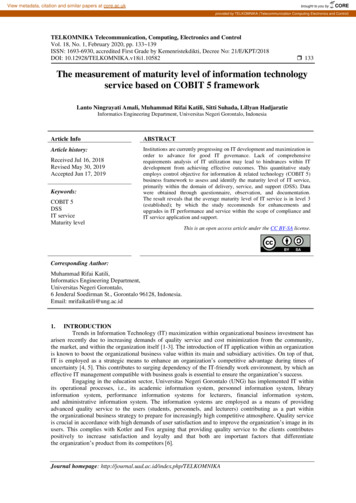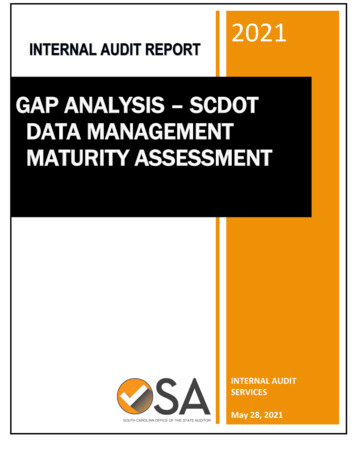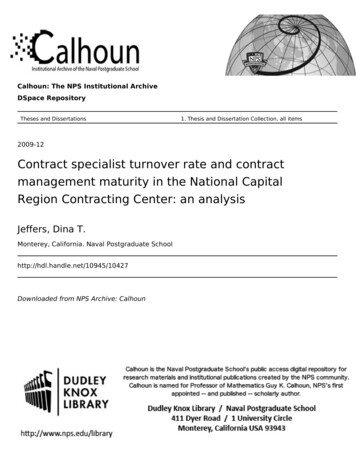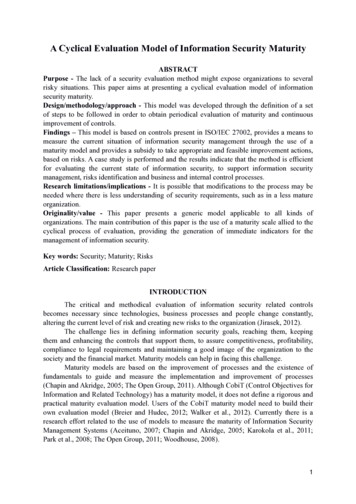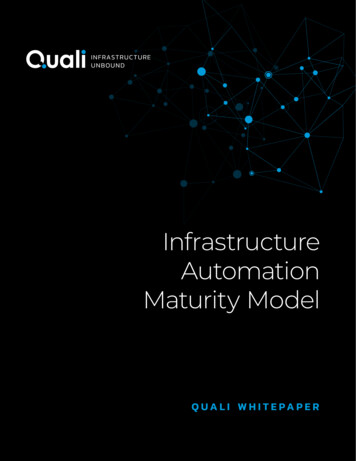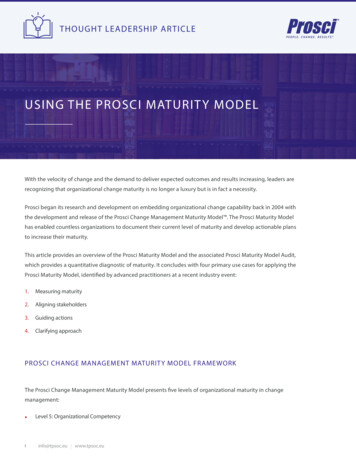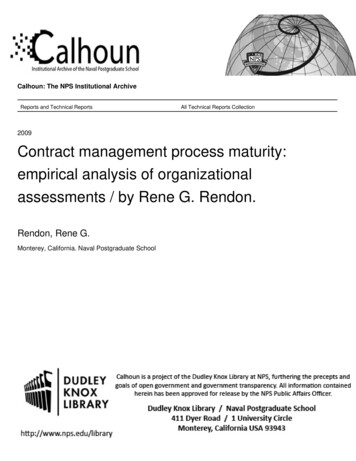
Transcription
Calhoun: The NPS Institutional ArchiveReports and Technical ReportsAll Technical Reports Collection2009Contract management process maturity:empirical analysis of organizationalassessments / by Rene G. Rendon.Rendon, Rene G.Monterey, California. Naval Postgraduate Schoolhttp://hdl.handle.net/10945/642
NPS-GSBPP-09-039 k s i mlpqdo ar qb p elli jlkqbobvI ifclokf Contract Management Process Maturity:Empirical Analysis of Organizational Assessments2 February 2010byDr. Rene G. Rendon, Associate ProfessorGraduate School of Business & Public PolicyNaval Postgraduate SchoolApproved for public release, distribution is unlimited.Prepared for: Naval Postgraduate School, Monterey, California 93943
THIS PAGE INTENTIONALLY LEFT BLANK
NAVAL POSTGRADUATE SCHOOLMonterey, California 93943-5000Daniel T. OliverPresidentLeonard A. FerrariExecutive Vice President andProvostThe Acquisition Program, Graduate School of Business & Public Policy, NavalPostgraduate School supported the funding of the research presented herein.Reproduction of all or part of this report is authorized.This report was prepared by:Rene G. Rendon, Associate ProfessorGraduate School of Business & Public PolicyReviewed by:William R. Gates, Ph.D.Dean, Graduate School of Business & Public PolicyReleased by:Karl A. van Bibber, Ph.D.Vice President and Dean of Research
THIS PAGE INTENTIONALLY LEFT BLANK
Form approvedOMB No 0704-0188REPORT DOCUMENTATION PAGEPublic reporting burden for this collection of information is estimated to average 1 hour per response, including the time for reviewing instructions, searching existing data sources,gathering and maintaining the data needed, and completing and reviewing the collection of information. Send comments regarding this burden estimate or any other aspect of thiscollection of information, including suggestions for reducing this burden, to Washington Headquarters Services, Directorate for information Operations and Reports, 1215 JeffersonDavis Highway, Suite 1204, Arlington, VA 22202-4302, and to the Office of Management and Budget, Paperwork Reduction Project (0704-0188), Washington, DC 20503.1. AGENCY USE ONLY (Leave blank)2. REPORT DATE2 February 20103. REPORT TYPE AND DATES COVERED1 October 2008 through 30 September 20094. TITLE AND SUBTITLEContract Management Process Maturity: Empirical Analysis of OrganizationalAssessments5. FUNDING6. AUTHOR (S)Rene G. Rendon7. PERFORMING ORGANIZATION NAME (S) AND ADDRESS (ES)NAVAL POSTGRADUATE SCHOOLGRADUATE SCHOOL OF BUSINESS AND PUBLIC POLICY555 DYER ROADMONTEREY, CA 93943-51039. SPONSORING/MONITORING AGENCY NAME (S) AND ADDRESS (ES)8. PERFORMING ORGANIZATION REPORTNUMBERNPS-GSBPP-09-03910. SPONSORING/MONITORINGAGENCY REPORT NUMBER11. SUPPLEMENTARY NOTES12a. DISTRIBUTION/AVAILABILITY STATEMENTApproved for public release; distribution is unlimited12b. DISTRIBUTION CODE13. ABSTRACT (Maximum 200 words.)This research builds upon the emerging body of knowledge on contract management workforce competence and organizationalprocess capability. In 2003, the Contract Management Maturity Model (CMMM) was first developed for the purpose of assessing anorganization’s contract management process capability. Specifically developed for the Department of Defense’s (DoD) contractingagencies and defense industry partners, the CMMM has been applied at Air Force, Army, Navy, and defense industry organizations. Duringthe period between 2007 and 2009, assessments were conducted at Army, Navy, Air Force, and joint DoD contracting organizations usingthe CMMM. These organizations included the Army Aviation and Missile Command, Naval Air Systems Command, Air Force LogisticsCenter, and the US Transportation Command. The primary purpose of this paper is to summarize the assessment ratings, analyze theassessment results in terms of contract management process maturity, discuss the implications of these assessment results for processimprovement and knowledge management opportunities, and provide insight on consistencies and trends from these assessment results toDoD contract management. This paper also discusses these assessment results in an attempt to characterize the current state of contractmanagement practice within the Department of Defense.14. SUBJECT TERMS15. NUMBER OFOrganizational process capability, assessment ratings, assessment resultsPAGES7116. PRICE CODE17. SECURITY CLASSIFICATION OFREPORT: UNCLASSIFIEDNSN 7540-01-280-580018. SECURITY CLASSIFICATION OFTHIS PAGE: UNCLASSIFIED19. SECURITY CLASSIFICATION OFABSTRACT: UNCLASSIFIED-i -20. LIMITATION OFABSTRACT: UUStandard Form 298 (Rev. 2-89)Prescribed by ANSI Std 239-18
THIS PAGE INTENTIONALLY LEFT BLANK-ii -
AbstractThis research builds upon the emerging body of knowledge on contractmanagement workforce competence and organizational process capability. In 2003,the Contract Management Maturity Model (CMMM) was first developed for thepurpose of assessing an organization’s contract management process capability.Specifically developed for the Department of Defense’s (DoD) contracting agenciesand defense industry partners, the CMMM has been applied at Air Force, Army,Navy, and defense industry organizations. During the period between 2007 and2009, assessments were conducted at Army, Navy, Air Force, and joint DoDcontracting organizations using the CMMM. These organizations included the ArmyAviation and Missile Command, Naval Air Systems Command, Air Force LogisticsCenter, and the US Transportation Command. The primary purpose of this paper isto summarize the assessment ratings, analyze the assessment results in terms ofcontract management process maturity, discuss the implications of theseassessment results for process improvement and knowledge managementopportunities, and provide insight on consistencies and trends from theseassessment results to DoD contract management. This paper also discusses theseassessment results in an attempt to characterize the current state of contractmanagement practice within the Department of Defense.Keywords: Organizational process capability, assessment ratings,assessment results-iii -
THIS PAGE INTENTIONALLY LEFT BLANK-iv -
About the AuthorDr. Rene G. Rendon is a nationally recognized authority in the areas ofsupply management, contract management, and project management. He iscurrently on the faculty of the United States Naval Postgraduate School where heteaches in the MBA and Master of Science programs. Prior to his appointment atthe Naval Postgraduate School, he served for more than 22 years as an acquisitionand contracting officer in the United States Air Force, retiring at the rank oflieutenant colonel. His Air Force career included assignments as a warrantedcontracting officer for the Peacekeeper ICBM, Maverick Missile, C-20 (GulfstreamIV), and the F-22 Raptor. He was also a contracting squadron commander for an AirForce pilot training base and the director of contracting for the Air Force’s SpaceBased Infrared satellite system, and the Evolved Expendable Launch Vehicle rocketprogram.Rendon has taught contract management courses for the UCLA GovernmentContracts program and was also a senior faculty member for the Keller GraduateSchool of Management, where he taught MBA courses in project management andcontract management. He is a graduate of the US Air Force Squadron OfficerSchool, Air Command and Staff College, Air War College, and the Department ofDefense Systems Management College. Rendon is Level III certified in bothProgram Management and Contracting under the Defense Acquisition WorkforceImprovement Act (DAWIA) program. He is also a Certified Professional ContractsManager (CPCM) with the National Contract Management Association (NCMA), aCertified Purchasing Manager (CPM) with the Institute for Supply Management(ISM), and a certified Project Management Professional (PMP) with the ProjectManagement Institute (PMI). He has received the prestigious Fellow Award fromNCMA, and he was recognized with the United States Air Force Outstanding Officerin Contracting Award. He has also received the NCMA National Education Awardand the NCMA Outstanding Fellow Award. Dr. Rendon is a member of the ISMCertification Committee as well as on the Editorial Review Board for the ISM Inside-v -
Supply Management magazine. He is a member of the NCMA Board of Advisors aswell as associate editor for its Journal of Contract Management. Dr. Rendon’spublications include Government Contracting Basics (2007), U.S. Military ProgramManagement: Lessons Learned & Best Practices (2007), and Contract ManagementOrganizational Assessment Tools (2005). He has also published scholarly articles inthe Contract Management magazine, the Journal of Contract Management, theProgram Manager magazine, the Project Management Journal, and the PM Networkmagazine. He is a frequent speaker at universities and professional conferences andprovides consulting to both government and industry.Rene G. Rendon, D.B.AAssociate ProfessorGraduate School of Business and Public PolicyNaval Postgraduate SchoolMonterey, CA 93945-5197Tel: (831) 656-3464E-mail: rgrendon@nps.edu-vi -
NPS-GSBPP-10- k s i mlpqdo ar qb p elli jlkqbobvI ifclokf Contract Management Process Maturity:Empirical Analysis of Organizational Assessments2 February 2010byDr. Rene G. Rendon, Associate ProfessorGraduate School of Business & Public PolicyNaval Postgraduate SchoolDisclaimer: The views represented in this report are those of the author and do not reflect the official policy position ofthe Navy, the Department of Defense, or the Federal Government.-vii -
THIS PAGE INTENTIONALLY LEFT BLANK-viii -
Table of ContentsI.Overview . 1II.Research Scope and Objectives . 3III.Conceptual Framework. 5IV.A.Procurement Development Models . 5B.Process Capability .6C.Capability Maturity Models . 8D.Contract Management Maturity Model. 10E.Contract Management Key Process Areas . 10F.Contract Management Process Maturity . 12Method . 17A.Survey and Sampling . 17B.Assessment Organizations .18V.Results . 21VI.Discussion . 27VII.A.Agency-level Analysis: Process Capability Consistency. 27B.Agency-level Analysis: Process Capability Maturity . 28C.DoD-level Analysis: Process Capability Consistency . 31D.DoD-level Analysis: Contract Management Best Practice Groups 35E.Summary Analysis .40F.Process Improvement and Knowledge Management Opportunities42G.Pre-award Phases . 42H.Post-award Phases . 44Conclusion. 47List of References . 49Initial Distribution List . 57-ix -
THIS PAGE INTENTIONALLY LEFT BLANK-x -
I.OverviewContract management has become increasingly important in the commercialindustry as well as in the federal government. As organizations continue to focus oncore competencies and outsource non-core yet critical functions, these organizationsare relying on contract management processes as a key to achieving andmaintaining a competitive advantage (Quinn, 2005; Patel, 2006).In addition, the federal government continues to increase its level of publicspending for goods and services. With a procurement budget of approximately 532billion in FY 2008 and an increase from 200 billion in FY 2000, federal governmentacquisition professionals are responsible for managing contracts for the procurementof critical supplies and services, ranging from commercial-type supplies toprofessional and administrative services to highly complex information technologysystems. Within the federal government, the Department of Defense (DoD) is thelargest contracting agency, procuring approximately 388 billion in FY 2008 (GAO,2009).The extent and amount of federal procurement spending necessitates thatthese contract management processes be well managed (Thai, 2004). However,recent Government Accountability Office (GAO) reports reflect that this is not thecase. The GAO has listed contract management as a “high-risk” area for the federalgovernment since 1990 and continues to identify it as high risk (GAO, 2007b,January; 2009). Within the federal government, the procurement and contractingfunction has been elevated to an organizational core competency (Kelman, 2001)and is receiving extensive emphasis in the areas of education, training, and thedevelopment of workforce competence models (Newell, 2007; GAO, 2007a,January). In addition to a focus on increasing individual contract managementcompetency, organizations are now focusing on increasing contract managementprocess competence through the use of organizational process maturity models.Just as individual competence will lead to greater success in performing tasks,-1 -
organizational process capability will ensure consistent and superior results for theenterprise (Frame, 1999; Kerzner, 2001).-2 -
II.Research Scope and ObjectivesThis paper analyzes the results of contract management process capabilityassessments conducted during the period 2007–2009 using the five-level ContractManagement Maturity Model (CMMM). The CMMM is used to assess anorganization’s contract management process capability and to develop a roadmapfor implementing contract management process improvement initiatives. Using thesurvey assessment tool, the CMMM was applied to Army, Navy, Air Force, and jointNavy DoD contracting agencies, as well as major defense contractors. The purposeof this research is to summarize the assessment ratings, analyze the assessmentresults in terms of contract management process maturity, and discuss theimplications of these assessment results for process improvement and knowledgemanagement opportunities. The assessment results and related recommendationsfor contract management process improvement and knowledge managementopportunities will guide the contracting agencies in developing a roadmap forincreasing contract management process capability. A thorough understanding ofthe current level of contract management process capability will help theseorganizations improve their procurement of defense-related supplies and services.This research will also discuss the assessment results by providing insight onconsistencies and trends in an attempt to characterize the current state of contractmanagement within the Department of Defense.The background and context of contract management process maturity and,specifically, the Contract Management Maturity Model will first be presented. Theassessed organizations will then be profiled, followed by the analysis of theassessment findings and implications for process improvement and knowledgemanagement opportunities. Finally, a brief discussion on consistent trends in thepractice of contract management throughout the DoD will be presented.-3 -
THIS PAGE INTENTIONALLY LEFT BLANK-4 -
III. Conceptual FrameworkA review of the procurement literature finds a body of knowledge focused onthe transformation of the procurement function from a tactical to a strategicperspective. Beginning with Henderson’s (1975) prediction of the purchasingrevolution in 1964 and extending to Kraljic’s (1983) work emphasizing the need for astrategic supply management perspective and Reck and Long’s research ondeveloping the purchasing function to be a competitive weapon (1988), researchshows the use of various organizational models for the development of theprocurement function. These development models reflect the transition ofprocurement from a tactical function to a strategic and then an integrative one.A.Procurement Development ModelsReck and Long’s (1988) model describes a four-stage development of theprocurement function from passive, to independent, to supportive, and, finally, tointegrative. Leender and Blenkhorn’s (1988) model describes the three degrees ofthe procurement function’s contribution to organizational objectives. Bhote’s (1989)model reflects four stages of procurement development, ranging from confrontationto arms length to goal congruence, and, finally, to full partnership. Freeman andCavinato (1990) present a four-stage procurement development model described asbuying, purchasing, procurement, and supply. Burt, Dobler, and Starling (2003)present a four-stage progression to world-class supply management. Thisprogression includes clerical, mechanical, proactive, and, finally, world-class.It should be noted that these procurement development models are based onthe development of the procurement function, specifically the procurement function’sorientation and support of organizational strategy and objectives. As noted by theliterature works cited earlier, some organizations’ procurement function reflects moreof a tactical purchasing perspective while other organizations’ procurement functionreflects a more strategic perspective. The development models found in theliterature reflect the stage of development of the organization’s procurement-5 -
function. These development models are not focused on the capability of theprocurement processes or the strength and maturity of the procurement processeswithin the organization. An organization’s procurement function can be in the earlystages of development from tactical to strategic, yet its procurement process mayreflect a high level of maturity. On the other hand, an organization’s procurementfunction may be at the later stages of development toward strategic procurement butmay have weak or immature procurement processes. These procurementdevelopmental models reflect the transformation of the organization’s procurementfunction, whereas capability maturity models are used to assess an organization’sprocesses to determine the degree of capability or maturity of those processes.B.Process CapabilityA review of the literature on process capability begins with the qualitymanagement research of Deming (1986), Juran (1988), and Crosby (1979). Fromthis research, a greater emphasis was placed on continuous process improvementand increasing the capability of organizational processes. Process capability, in thissense, is defined as "the inherent ability of a process to produce planned results"(Ahern, Clouse, & Turner, 2001, p 4). As the capability of a process increases, itbecomes predictable and measurable (Ahern, Clouse, & Turner, 2001). Deming,Juran, and Crosby revealed that as process capability increases, the inherent abilityof a process to produce planned results also increases, thus becoming morepredictable and measurable. This increase in process capability results in theorganization controlling or eliminating the most significant causes of poor quality andproductivity. As organizations steadily improve their process capability, they increasetheir competence and thus become more mature (Ahern et al., 2001). Competence,in this case, is defined as "an underlying characteristic that is causally related toeffective or superior performance, as determined by measurable, objective criteria,in a job or in a situation" (Curtis, Hefley, & Miller, 2001). Maturity can be defined as ameasure of effectiveness in any specific process (Dinsmore, 1998).It is important to note that process maturity is not related to the passage oftime. Different organizations mature at different rates, depending on the nature of-6 -
the business and the emphasis placed on process improvement. Process maturity ismore reflective of how far an organization has progressed toward continuouslyimproving its process capability in any specific area. An organization's processcapability maturity level describes the level of organizational capability created bythe transformation of one or more domains of an organization's process. It is anevolutionary plateau on an organization's improvement path from ad hoc practices toa state of continuous improvement (Curtis et al., 2001).By the 1990s, it became clear that for organizations to remain competitive inthis dynamic marketplace, they must operate competently and with capable, matureorganizational processes. Organizational competence would lead to higher levels ofmaturity or learning capability (Yueng, Ulrich, Nason, & Von Glinow, 1999), thusenabling them to produce high-quality goods and services faster, cheaper, andbetter than their competitors. Even more important was the concept that the degreeof organizational competence and level of maturity could be described and assessedobjectively according to some generally accepted evaluation criteria.Frame (1999) expands on this concept by describing the environment thatsupports organizational competence. Frame states that organizations demonstratecompetence when they provide their employees with clearly defined and wellformulated procedures for performing work, access to information needed to performwork effectively, sufficient quantities of qualified human and material resources, andopportunities for training and education. Frame also identified a clearly definedorganizational vision of where the organization is headed, a culture of openness,and the institutionalization and management support of organizational processes aselements needed for achieving competence.Frame (1999) also discusses the common features for assessingorganizational competence, including adopting performance standards, assessingwhat it will take to achieve these standards, developing an organizational plan toachieve these standards, implementing the plan, assessing the organization to seewhether it is meeting these standards, and documenting the findings. The use of-7 -
maturity models as a method for describing, measuring, and assessingorganizational capability maturity began to take hold along with the movementtoward total quality management.C.Capability Maturity ModelsCapability maturity models have been used by many organizations to assessthe level of capability and maturity of their most critical processes. In these maturitymodels, process capability is defined as “the inherent ability of a process to produceplanned results” (Ahern et al., 2001), and maturity is defined as “a measure ofeffectiveness in any specific process” (Dinsmore, 1998). Some of the better-knowncapability maturity models include the Software Engineering Institute (SEI) CapabilityMaturity Model (SEI CMM), People Capability Maturity Model (People CMM), andthe Project Management Maturity Model (PMMM). Most maturity models are built ona series of maturity levels—with each maturity level reflective of the level ofcompetence for that process. As the organization gains process competence, itmoves up the maturity scale. As maturity increases, so does capability andpredictability while risk decreases.In 1986, the Software Engineering Institute (SEI), with assistance from theMITRE Corporation, began developing a process maturity framework intended toassist organizations in improving their software engineering process. The fullydeveloped Capability Maturity Model (CMM) and associated questionnaire wasreleased in 1993 (Ahern et al., 2001). The SEI CMM has become the most influentialquality management system in the United States software industry (Persse, 2001).The CMM is based on five maturity levels: Level 1–Initial, Level 2–Repeatable, Level3–Defined, Level 4–Managed, and Level 5–Optimizing (Persse, 2001; Ahern et al.,2001).In 1995, the People Capability Maturity Model (People CMM) was firstpublished as a continuous process improvement guide for developing the capabilityof an organization’s workforce. The model focuses on improving the processcapability for attracting, developing, organizing, motivating, and retaining an-8 -
organization’s workforce. The People CMM has been successfully implemented incompanies such as Boeing, Lockheed Martin, Ericsson, Novo Nordisk IT A/S, andTata Consulting Services. The People CMM is structured similarly to the othercapability maturity models currently in the software management and projectmanagement fields. The People CMM consists of five maturity levels and is focusedon specific workforce management and development processes and sub-processes.The People CMM also uses a questionnaire-based maturity assessment as anoptional method for conducting people capability maturity assessments.The application of capability maturity models to the project management fieldhas been the topic of recent field research within academia as well as projectmanagement training and consulting companies (Bolles, 2002; Crawford, 2001; Foti,2002; Kerzner, 2001; Ibbs & Kwak, 2000; Jugdev & Thomas, 2002; Helms, 2002).This recent field research extends the theory of the Software Engineering Institute'sCMM model and applies this framework to the project management discipline. Thereare several project management maturity models currently in use today. Kerzner'sProject Management Maturity Model (PMMM), similar to the SEI CMM and otherproject management maturity models, is comprised of five levels, with each levelrepresenting a different degree of organizational maturity in project management.The PMMM is based on five maturity levels: Level 1–Common Language, Level 2–Common Processes, Level 3–Singular Methodology, Level 4–Benchmarking, andLevel 5–Continuous Improvement (Kerzner, 2001).The SEI CMM, People CMM, and Kerzner maturity models are excellentexamples of how the concept of capability maturity models have been applied to thesoftware management, workforce management, and project managementprocesses. The purpose of this abbreviated literature review was to show thatmaturity models are effective methods for assessing and improving organizationalcompetence and maturity. The next section will discuss the application of thematurity model concept to contract management.-9 -
D.Contract Management Maturity ModelThe maturity model concept was first applied to contract management byRendon (2003). With the increase in importance of the procurement function andwith the procurement function’s transformation from a tactical to a strategicperspective, the Contract Management Maturity Model (CMMM) was developed toassess the capability and maturity of an organization’s contract managementprocesses (Rendon, 2003). “Contract management,” as used in the model, isdefined as the “art and science of managing a contractual agreement throughout thecontracting process” (Garrett & Rendon, 2005, p. 270). “Maturity,” as defined in themodel, refers to organizational capabilities that can consistently produce successfulbusiness results for buyers and sellers of products, services, and integratedsolutions (Garrett & Rendon, 2005). Thus, contract management refers to thebuyer’s (procurement) process as well as the seller’s (business development andsales) process. The CMMM assessments analyzed in this research focused only onthe buyer’s procurement process. The structure of the CMMM is based on sixcontract management key process areas, five levels of contract managementprocess capability maturity, and the CMMM assessment tool.E.Contract Management Key Process AreasThe CMMM provides the organization with a detailed roadmap for improvingthe capability of its contract management processes. The model reflects the sixcontract management key process areas as well as key practice activities withineach process area. These contract management key process areas are describedbelow.1.Procurement PlanningThe process of identifying which organizational needs can be best met byprocuring products or services outside the organization. This process involvesdetermining whether to procure, how to procure, what to procure, how much toprocure, and when to procure. Procurement planning activities include conducting-10 -
stakeholder analyses, conducting outsourcing analyses, determining requirementsand developing related documents, conducting market research, selecting theprocurement method, and selecting the contract and incentive type.2.Solicitation PlanningThe process of preparing the documents needed to support the solicitation.This process involves documenting program requirements and identifying potentialsources. Solicitation planning activities include developing solicitation documentssuch as RFPs (Request for Proposal) or IFBs (Invitation for Bid), developing contractterms and conditions, and developing proposal evaluation criteria.3.SolicitationThe process of obtaining information (bids or proposals) from prospectivesellers on how project needs can be met. Solicitation activities include advertisingprocurement opportunities, conducting industry and pre-proposal conferences, andamending solicitation documents as required.4.Source SelectionThe process of receiving bids or proposals and applying evaluation criteria tose
This research builds upon the emerging body of knowledge on contract management workforce competence and organizational process capability. In 2003, the Contract Management Maturity Model (CMMM) was first developed for the purpose of assessing an organization's contract management process capability.
